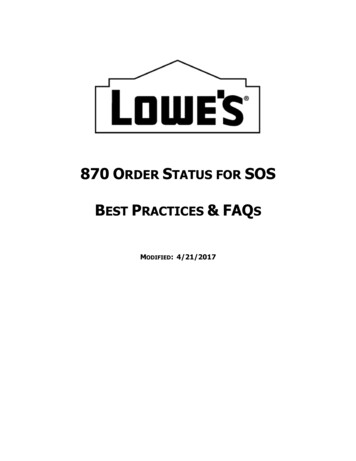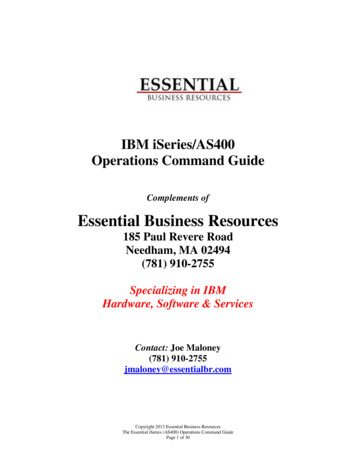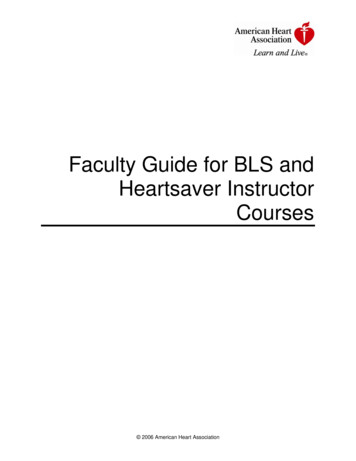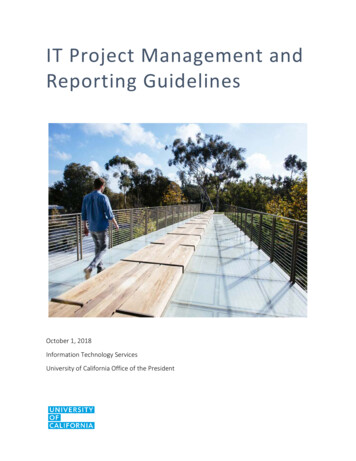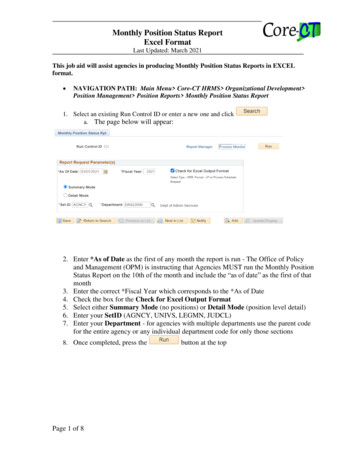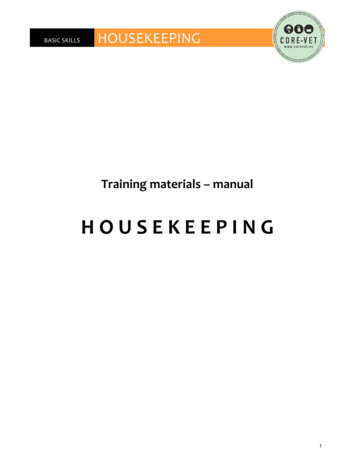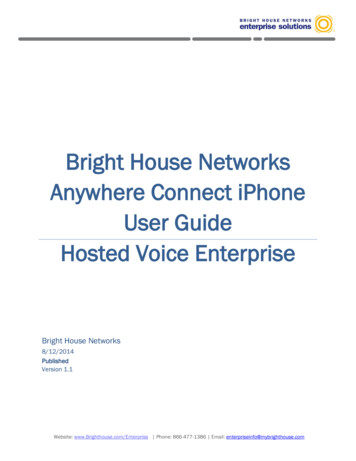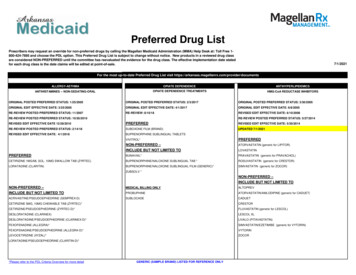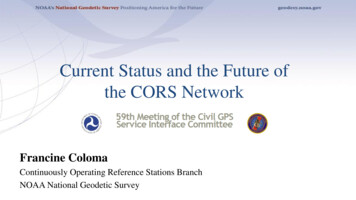
Transcription
Current Status and the Future ofthe CORS NetworkFrancine ColomaContinuously Operating Reference Stations BranchNOAA National Geodetic Survey
NOAA’sMissionTo understand and predictchanges in climate, weather,oceans, and coasts, to sharethat knowledge andinformation with others,and to conserve andmanage coastal and marineecosystems and resources.CORSNetwork
The National Spatial Reference System (NSRS)constitutes the official system of the civilian government forenabling a user to determine geodetic latitude, longitude, andheight, plus orthometric height, geopotential, acceleration ofgravity, and deflection of the vertical at any point within theUnited States and its territories.Contains information about its orientation and scale relativeto international reference frames, as well as the precise orbitsof all satellites used in defining or accessing the NSRS.The NSRS is crucial for meeting our nation’s economic,social and environmental needs.
NSRS Geodetic controlUnattributed photo from internetWithout a geodetic control “base map” layer,GIS applications will not work properly!
Continuously Operating Reference Stations(CORS) NGS operates a network of 1900 stations that provide GPSor GNSS data consisting ofcarrier phase and code rangemeasurements in support ofthree dimensional positioning Contributions by more than200 organizations (variousgovernment, academic, andprivate organizations)
NGS’ MissionTo define, maintain and provideaccess to the National SpatialReference System (NSRS) to meetour Nation’s economic, social, andenvironmental needs.Web site: https://www.ngs.noaa.gov/CORS/Email: ngs.cors@noaa.gov
Continuously Operating Reference Stations(CORS)CORS Cumulative Network Status1888 active(852 decommissioned)Decommissioned,852, 31%Preliminary, 11,0%Non-Operational,155, 6%Operational,1722, 63%
Continuously Operating Reference Stations(CORS)
CORS ArchiveSince 2004, at-samplingCORS RINEX data(where available) isdirectly available online.NGS only keeps 30 daysof at-sampling data, thendecimates to 30-secondsampling rate online.Data is free, but you mustregisterCORS onlinearchive repositoryat NOAA’s CLASS
Guiding Principles forContinuously Operating Reference Stations (CORS) By 2022, the National Spatial Reference System (NSRS) will bemodernized, with CORS becoming a more foundational component. The International Earth Rotation and Reference Systems Service (IERS)International Terrestrial Reference System (ITRF) will continue to be theworldwide standard reference system. NGS will continue to support the ITRF through International GNSS Service(IGS) reference sites with the “Foundation CORS” network The NSRS will continue to be defined in relation to the ITRF.
Notable Events Ongoing discontinuance of the USCG DGPS Service to culminate in year 2020 GPS Rollover, second epoch ended on 2019 April 06–GPS Time was defined in the legacy GPS navigation message (ICD-200), and used 10bit to count GPS Week Numbers: a finite period of 1024 weeks (19.7 year epoch)–Modernized GPS Navigation has 13-bit week number, and mitigates the formerambiguity Ridgecrest Earthquake Sequence in 2019 July 4 – 6–Mw 7.1 (2019 July 16 03:19 UTC) Completion of Multi-Year CORS Solution 2 (MYCS2)–An undertaking of several years’ work–New CORS coordinates and velocities available in NAD83 and ITRF Foundation CORS process underway
Multi-Year CORS Solution 2 (MYCS2) ReleasedAs of Last Week (Sept 13th): You now have access to more accurate NOAA CORS Network stationcoordinates and velocities in both the national (NAD83) and international (ITRF) reference framesWhat:New robust coordinates and velocities in ITRF2014and NAD83(2011) epoch 2010.00 (a within-realizationupdate) for all NCN stations installed before 2014.Modeled coordinates and velocities available forstations installed between 2014 and present.How:Two years of detailed quality control on all datacollected by the NCN over 22 years (1995-2017).A full network adjustment of 3050 stations, 1100weeks of data for all NCN stations installed before2014 (active and decomm.), IGS, and NGAstations.New GPS orbits to match with ITRF2014.Updated OPUS online positioning software uses thenew coordinates and velocities, and new GEOID18. 240 new CORS ( 3 yrs old) have approximatecoordinates and velocities “modeled” with OPUSNet and HTDP(lower accuracy than the network solution).
The NOAA Foundation CORS NetworkU.S. FederalPartnersGNSSSite IDNSF Existing SitesWales, AKPetersburg, AKAtqasuk, AKNew Castle, WYDennard, ARThe Rock, GAPedro Cay, JamaicaProgram: COCONetSAN0San Andres Island, ColombiaBREWCRO1FAIRBrewster, WASt. Croix, VIFairbanks, AKITRFITRFIGSTBDGreenbelt, MDIGS/ITRFGUAMDededo, GuamIGSHaleakala, HIKauai, HIMcDonald Observatory, TXMauna Kea, HIMount Laguna, CAPie Town, Pago Pago, American SamoaIGSBRSGSt. George, BermudaExisting SitesProgram: Network ofthe Americas (NOTA)NationalAeronautics obal GNSS NetworkMKEA(GGN)MONPPIE1Existing SitesCORBSaipan, Northern MarianaIslandsWoodford, VAFLF1Richmond, FLGUUGMangilao, GuamTMG2Boulder, COCNMRNOAA- NationalGeodetic Survey(NGS)Existing and NewSitesA set of federally-operated, high quality, highly reliable stations with thelongevity to guarantee citizens’ access to official NSRS positions and tosupport international positioning consistency efforts.Existing IGSor ITRF SiteAB09AB51ATQKP043P777P804CN11National ScienceFoundation (NSF)26 in North America,4 in the Pacific,3 in the Caribbean, and3 in the Marianas.LocationWES2NEWProgram:NEWNOAA CORS NetworkNEWNEWNEWNEWNEWNEWNEWWestford, MAApache Point, NMFort Davis, TXFort Irwin, CAHancock, NHLos Alamos, NMKitt Peak, AZOwens Valley, CACold Bay, AKNorth Liberty, RFITRFITRFITRFITRFITRFITRFITRFITRF
Goals of Foundation CORS ProjectFederally-owned and operated “backbone” Chosen for location, longevity, and high quality Operational Goals:o Non-operational time minimized for each stationo 90% of NOAA Foundation CORS Network availableat any time (no more than 4 stations non-operational)Deep-drilled, braced monumentdesign for some new installationsAll stations are critical to some function of the new NSRS, including: A geographic distribution no greater than 800 km to provide minimum 1.5 cmaccuracy ellipsoidal height results through NGS’ OPUS tools anywhere in the U.S. 22 out of 36 stations are (currently or will be) co-located with other space geodeticstations supporting the IGS/ITRF, which the NSRS depends on
Three Ongoing Phases of Foundation CORSPhase 1: Incorporate partner stationsExisting NASA, NSF, and Caribbean partnerstations brought into the Foundation CORSnetwork.[NASA MOU expected approval by November 2019.Started discussions with NSF.]Phase 3: Construct 8 new stationsThese NGS-owned stations will be co-located at sites withexisting space geodetic techniques[Planning for Fort Davis, TX and Apache Point, NMstation installations in 2020]Phase 2: Upgrade existing NGS CORSUpgrades include fully-GNSS equipment andsubmission to IGS to meet Foundation CORSrequirements[RINEX3 development underway. 5 of 7 existing NGSFoundation CORS are fully-GNSS enabled]Foundation CORS at NGS’ Table Mountain GeophysicalObservatory in Boulder, CO, installed 2018 (ID: TMG2)
NOAA CORS Network Quality% of Stations# of StationsHorizontal MotionVertical Motion64%1139 3 mmAND 6 mm35%623 5 mmAND 10 mm1%16 5 mmOR 10 mm
Continued Modernization EffortsBetter access to the National Spatial Reference System (NSRS) Goal: achieve sustained quality of 5 mm horizontal, 10 mm vertical(See Blueprint Part 3) That’s nearly 75% BETTER than before All but 16 CORS met the standard as of MYCS2 end date in 2017 Today (2.5 yrs later), motion (e.g. Ridgecrest Earthquake, July 2019) meansmore stations are out of spec and need to have coords/velocities repaired.
Continued Modernization EffortsNOAA CORS Network Comprehensive Plan (Expected Fall 2020)Present new ways to: Redesign the CORS website with dynamic plots, new metrics, faster refresh Improve OPUS’ selection of CORS by providing it with better CORS data qualitystatistics Repair out-of-spec stations and provide new station coordinates more quickly Provide an OPUS tool to track NSRS coords/velocities for any continuous GNSSstation Increase CORS data provider and data user communications Better models of motion, for both plate rotation and regional motion (IFVM) Automate more of the network management at NGS
Planned NDGPSdiscontinuance by 2020https://www.navcen.uscg.gov/?pageName dgpsMain
SWPC’s GPS balpositioning-system-gps-community-dashboardLearn more about space weather and GPS/GNSS laterthis session.
Station NCBX at CapeHatteras SecondarySchool in Buxton, NCNGS Emergency Response Imagery at https://storms.ngs.noaa.gov/Hurricane DORIAN(2019 Aug-Sep)
Acknowledgements to the following:CORS Division Chief Theresa Damiani, for her contribution of the Foundation CORS andMultiyear CORS Solution 2 (MYCS2) powerpoint slidesTo Kevin Choi, Giovanni Sella, and Richard Snay, the previous Chairs of the CGSIC User Forum(now the Survey, Mapping and Geosciences) subcommittee, for their guidance and supportTo the CORS team: Steve Briedenbach, Will Freeman, Don Haw, Phillip McFarland, Jarir Saleh,Ira Sellars, Lijuan Sun, Sungpil Yoon, for their expertise, endurance, and supportOur Partners and Data Contributors for volunteering their geodetic stations, networks, time andefforts in coordination with NGS to make a robust contribution towards the NSRS. You are alldeeply appreciated
Updated OPUS online positioning software uses the new coordinates and velocities, and new GEOID18. How: Two years of detailed quality control on all data collected by the NCN over 22 years (1995-2017). A full network adjustment of 3050 stations, 1100 weeks of data for all NCN stations ins

